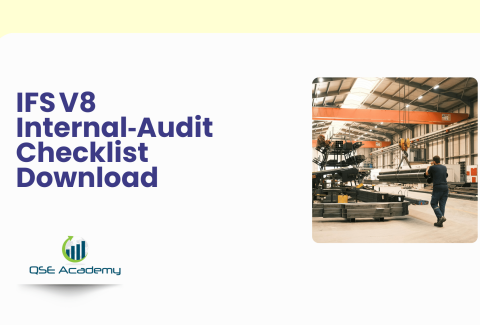IFS V8 Corrective Actions for Audit Findings
Last Updated on November 19, 2025 by Melissa Lazaro
Why Corrective Actions Matter in IFS V8 Compliance
Receiving findings in an audit can feel uncomfortable—especially if you believed your system was solid. I’ve worked with organizations across food production, packaging, logistics, and retail supply chains, and the pattern is consistent: what separates high-performing sites from stressed ones isn’t whether they get findings…but how they respond to them.
Most teams ask the same questions after an audit:
- “What exactly do we need to submit?”
- “How deep should our root-cause analysis go?”
- “What evidence is acceptable?”
IFS V8 expects corrective actions to be thoughtful, traceable, and effective—not rushed or superficial. By the end of this guide, you’ll know how to approach findings with confidence, manage timelines, and prepare evidence that satisfies auditors the first time.
Understanding IFS V8 Expectations — What Happens After the Audit
Once your audit is completed, the next step is addressing the findings. IFS V8 has clear expectations around how corrective actions are handled, including what must be submitted and when.
IFS terminology matters here:
- Correction: Fixing the immediate issue (e.g., completing a missing record).
- Corrective Action: Preventing the issue from happening again.
- Root Cause Analysis: Understanding why the issue occurred—not just what happened.
A simple example:
- Missing metal detector check → correction
- Updating checklist and training operators → corrective action
Where teams often struggle is submitting generic responses like:
“Operator retrained.”
IFS auditors expect evidence-driven answers—and a system-level fix, not a band-aid.
Root Cause Analysis — Going Beyond the Obvious
The most difficult skill for many teams is identifying the real root cause. Too often, the first answer sounds like:
“Human error.”
But in most cases, human error is a symptom—not the cause.
IFS V8 doesn’t require a specific tool, but it does expect a structured approach. The most useful ones tend to be:
- 5 Why’s
- Fishbone/Ishikawa Diagram
- Barrier or process mapping
Here’s what I remind teams:
if the same type of non-conformity appears again, the root cause wasn’t correctly identified.
Involving the operators who perform the task—not just managers—often reveals blind spots like unclear instructions, poor layout, confusing forms, or missing validation steps.
Developing Effective Corrective Actions — Turning Analysis Into Real Change
Once the root cause is clear, the corrective action needs to resolve it—not just address the outcome.
A strong corrective action typically includes:
- What will change
- Who is responsible
- When it must be completed
- How effectiveness will be verified
For example, if allergen label errors happened because multiple label versions were stored in the same area, the corrective action shouldn’t be “tell operators to be careful.”
It should involve:
- Controlled label storage
- A verification step
- Updated work instructions
- Training aligned with the new process
A helpful mindset:
Corrective actions should make the process easier to do right—and harder to do wrong.
Documenting and Submitting Evidence — What Auditors Expect
Once your corrective actions are implemented, the final step is documenting them clearly.
IFS auditors typically expect evidence such as:
- Updated SOPs or forms
- Photos or screenshots of changes
- Training records
- Calibration or validation reports
- Updated risk assessments
- Internal audit records confirming closure
The goal is to make it easy for the auditor to understand what changed—and how you proved success.
A short, well-organized response earns far fewer follow-up questions than long explanations without proof.
Verification and Effectiveness Checks — Proving It Worked
Closing the corrective action doesn’t mean the process is finished. Under IFS V8, you’re expected to verify effectiveness.
Examples include:
- Follow-up internal audit
- Operator interview or competency check
- Trending results over time
- Additional monitoring
One company I supported discovered that repeated Minor findings disappeared only after adding monthly micro-audits—not just updating paperwork.
The mindset shift is simple:
Compliance isn’t confirmed when the form is updated—it’s confirmed when behavior is consistent.
Preventing Repeat Findings — Turning Results Into Continuous Improvement
Corrective actions should feed into a wider improvement framework.
Useful techniques include:
- Categorizing findings by theme (e.g., documentation, allergen, hygiene, traceability)
- Tracking trends over time
- Reviewing results in management meetings
- Assigning improvement responsibility—not just corrective tasks
When teams use findings as insight rather than blame, culture and performance change noticeably.
FAQs — Quick Clarifications
Do small findings still require full root-cause analysis?
Yes—especially if there’s any chance of recurrence.
Can corrective actions be updated after submission?
Yes, but communication with the certification body is key.
What happens if the corrective action isn’t accepted?
You’ll need to resubmit with additional evidence or clarification.
Conclusion — Final Thoughts and Next Step
Corrective actions aren’t just an audit requirement—they’re an opportunity to strengthen systems, reduce risk, and create consistency across operations. When approached with structure and clarity, they build confidence—not stress.
If you’re ready, I can turn this into:
- A corrective action template
- A worked example for common findings
- Or a full internal training guide for your team
Melissa Lavaro is a seasoned ISO consultant and an enthusiastic advocate for quality management standards. With a rich experience in conducting audits and providing consultancy services, Melissa specializes in helping organizations implement and adapt to ISO standards. Her passion for quality management is evident in her hands-on approach and deep understanding of the regulatory frameworks. Melissa’s expertise and energetic commitment make her a sought-after consultant, dedicated to elevating organizational compliance and performance through practical, insightful guidance.







